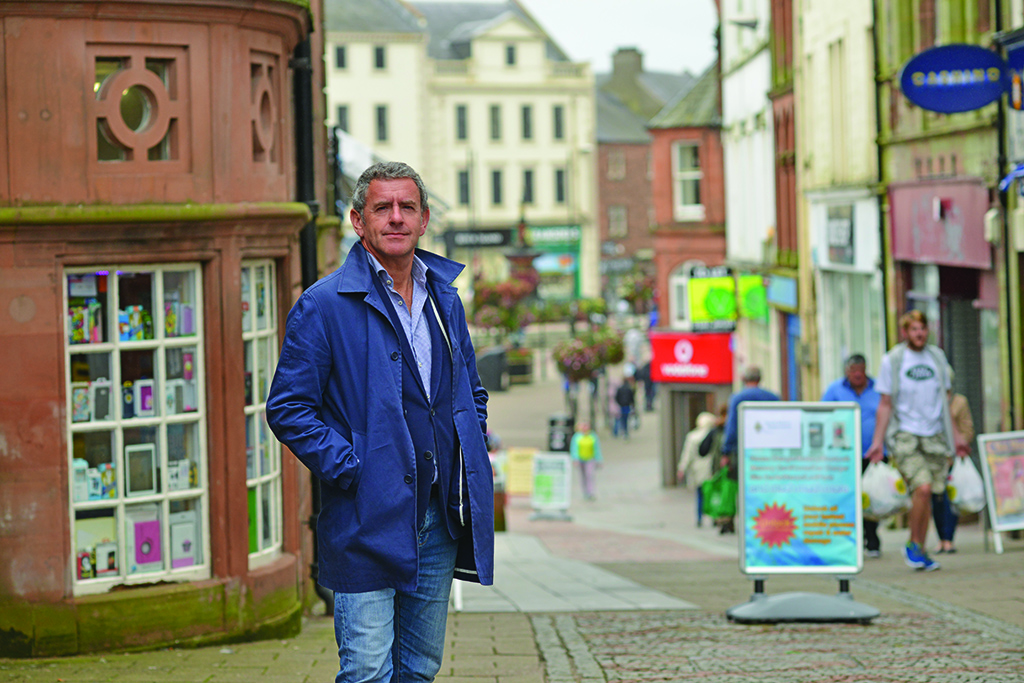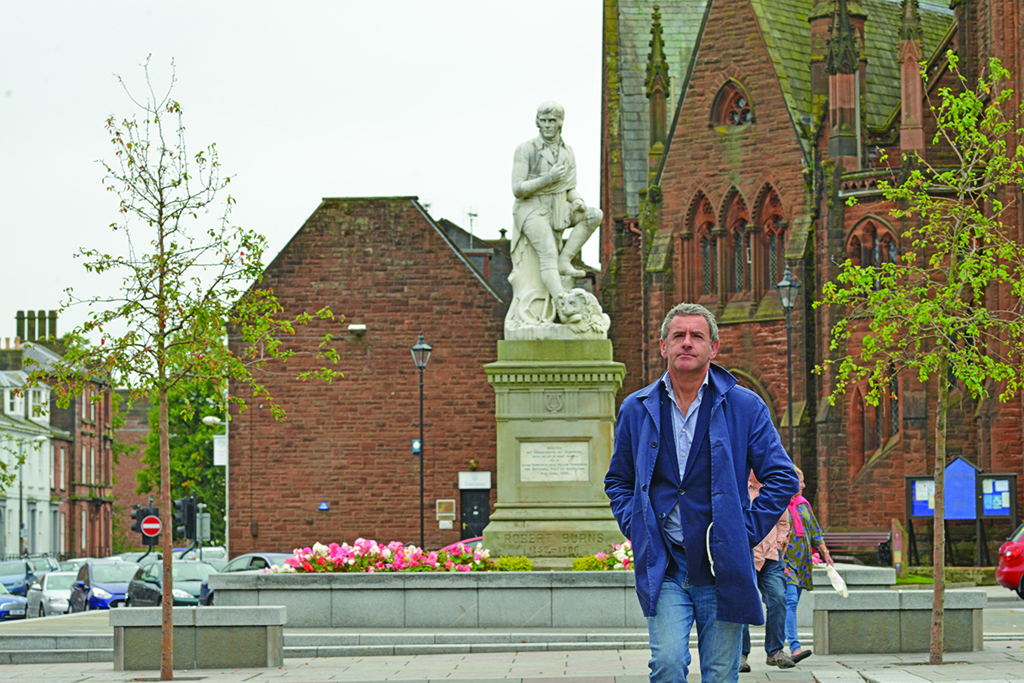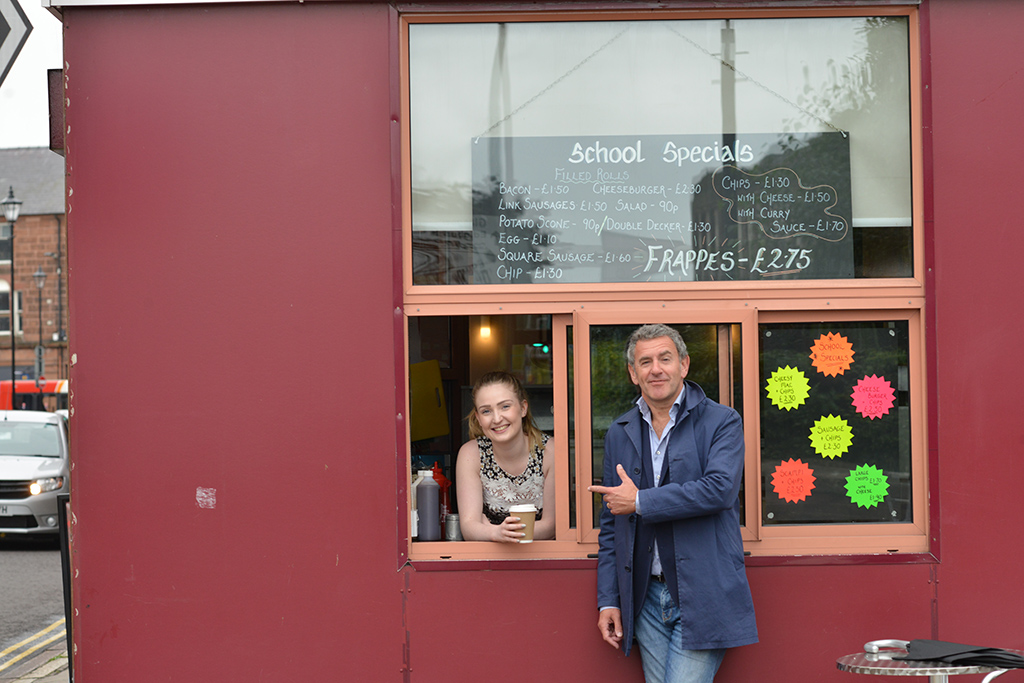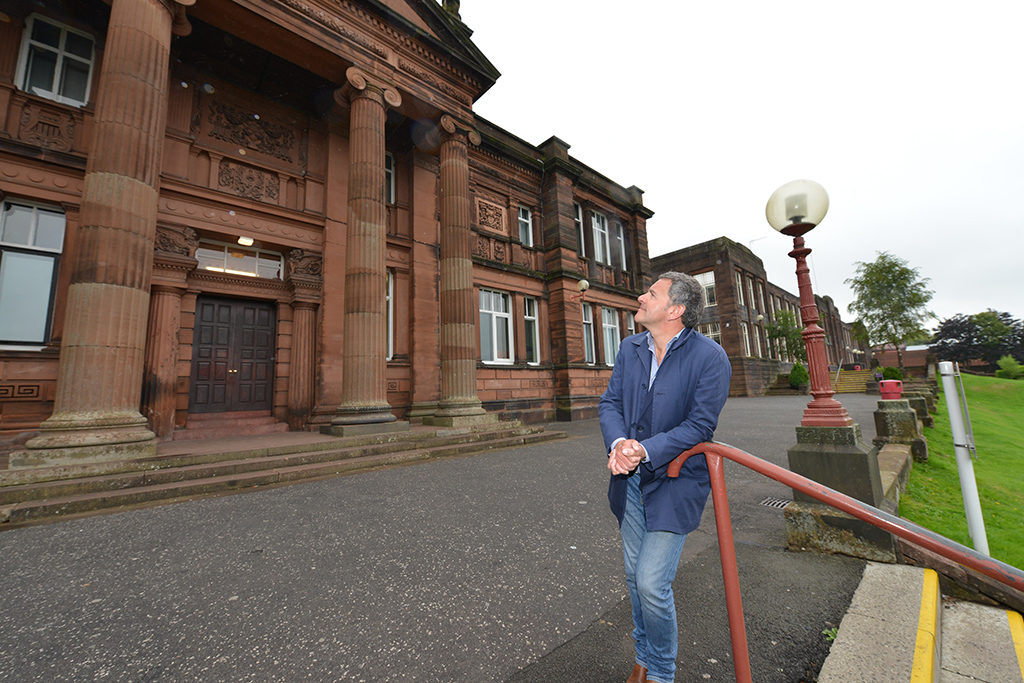
New BBC show host is so proud of his Dumfries roots
Journalist and broadcaster Stephen Jardine will present a new current affairs programme on the new BBC Scotland channel.
The first of 24 episodes of Debate Night will air on Wednesday 27 February at 10.45pm during the channel’s launch week.
Each hour-long programme will allow a studio audience to put questions to people in power in Scotland.
However Stephen can’t work out why his native Dumfries is still such a well-kept secret in Scotland.
My great-grandfather was a master cabinet-maker, and I remember in my granny’s house there was this beautiful, old, ornate wardrobe that he had made with his own hands. These skills have been gradually watered down to the point where I can’t put up an IKEA shelf, but back in the day, my family were all really skilled craftsmen and joiners, and the town’s funeral directors as well.
So there was no history in journalism until my dad ended up working for the Dumfries & Galloway Standard and worked his way up to eventually become the manager of the paper and then a director of Scottish Universal Newspapers, so he ran the paper down here. I remember when I was growing up one guy coming to the house and saying to my dad ‘Can you keep this out of the paper?’ because he’d been in court and been done for drink driving that day. That used to happen.
That was back in the seventies and eighties, and that’s how I got interested in journalism. After school I’d hang about in the office; it was back in the days of hot metal and you could smell the print room as soon as you went into the close off the main street. The print room was hot and dirty, but then you’d go up the stairs to the newsroom where the journalists all sat round one big wooden table in the midst of this fug of Capstan full strength; I can still remember the smell of that room. My dad was in the front office where they did sales and advertising.
The journalists all seemed to be kind of exotic, and I always remember my dad having arguments with them about these ridiculous expenses claims. I kind of thought ‘that’s quite interesting’. I wasn’t interested in the back end, which was just dirty, and smelly, and hot, and hard work, but the journalists were all big drinkers, there was always bottles of scotch on the newsroom desk.

Stephen Jardine, back home in Dumfries (Photo: Angus Blackburn)
They were all blokes and they were all big characters. I guess that’s where the seed of it came from. So right through my schooldays at the Academy I did the school newspaper and magazine. The Scotsman used to have a competition for the best school magazine in Scotland, so the English teacher who mentored us entered it and we won. The prize was a trip to Amsterdam for the four of us who worked on it, and after four all-expenses paid days in Amsterdam as a 17-year-old I came back thinking ‘if this is journalism, bring it on’. It was my first time abroad.
We went to a newspaper and a radio station in Holland, and that kind of cemented it for me, it showed me there’s a big world out there. After doing history and English at Edinburgh, I did a post-grad in journalism in Cardiff and specialised in broadcasting. My first job was on Radio Tay in Dundee 1988. That was a tough old gig, a real hard news place where everything was court-based stuff, murders. It was before any of the regeneration of Dundee, so it was a tough and rough place to work, and a world away from my gentle home town.
The Dumfries I grew up in was still a market town. The market was every Wednesday on the Whitesands: one of my earliest memories is the farmers bringing sheep and cattle actually into the heart of the town, and holding the auction in the town centre, surrounded by their wives and children, who would all follow them in on market days. The Whitesands was a very social place: the buses also came in there so it’s where you picked people up from the rows and rows of red and yellow buses. The Whitesands is now a car park but it was where you met people.
Market days were a big deal. They had a smaller market on Saturday as well, when the shops, restaurants and bars would be rammed. It felt very vibrant and prosperous. I’ve got really happy memories growing up here, of it being a really sleepy but prosperous little corner of Scotland, like a lot of rural towns were back then. It’s changed a lot since then, lost a lot of its butchers, bakers and the like. It feels a bit more homogenous these days: they must regret putting up the Loreburn Centre, a covered shopping centre, and the out-of-town shopping hasn’t helped.
I remember Binns department store of course, and drooling at the tiny model soldiers in the window of Young’s Toy Shop as a kid. Barbour’s is still going, but it’s the last vestige of how it used to be. The whole place could do with a lick of paint to be honest.

Stephen near the Robert Burns statue in Dumfries (Photo: Angus Blackburn)
It’s always saddened me that Dumfries is hugely overlooked by tourists, who hit the border and keep going until at least the Trossachs. It’s a pity because Dumfries & Galloway is beautiful and is still my favourite part of Scotland. I love the scenery down here, but it is too often overlooked
This county has it all. If you head west to Newton Stewart and New Galloway, or do the drive from New Galloway to Ayr, it’s really wild. I was down walking the Solway coast with my brother the other day and it was stunning. Kippford, Rockcliffe and Sandyhills are just beautiful, and I’d recommend the walk up the Waterloo Monument. There’s no nicer part of Scotland when you get the weather.
Those people who overlook Dumfries itself are missing out because there’s so much history in the town. Who knows, for instance, that Bonnie Prince Charlie once stayed in the county hotel and held the town to ransom – he demanded they provide his troops with shoes before he would move on.
If you stop to look up, the architecture is amazing. It’s not all ancient history either. The big steeple in the centre of town is the old tollbooth where they hold the culmination of the week-long Guid Nychburris festival, the riding of the marches ceremony, every June. The Queen of the South is crowned and all the horsemen and women – including the Cornet’s Lass, the Cornet, Lord Lieutenant and the Pursuivant – ride up the street and congregate at the tollbooth. It’s an incredible spectacle.
The Queen of the South gets crowned at the tolbooth and then a local schoolgirl sings Queen of the South. Doonhamers are incredibly proud of their heritage, and that song gets drummed into you at school. Forty years on, I can’t remember my pin number, but I can remember the words of Queen of the South:
‘Queen of the South, Queen of the South, thy loveliness, Till Criffel sink and River Nith run dry,
May heaven maintain, may heaven maintain thy honour high’
Everywhere you look in Dumfries, history is all around you. I had my first legal pint in the most famous pub in the town, The Globe Inn, where Robert Burns used to drink, and a few illegal ones long before that in places like another great Burns pub, the Hole in the Wa’, which dates back to 1620. The Globe has hardly changed since Burns’ day. The tiny wood-panelled room where Burns sat down and had a pint and ate his meal is almost as he left it, complete with his chair. His signature is reputed to be scratched in an upstairs window.
They say Dumfries had more pubs per head of population than any other town in Scotland, and I suspect that might still be true. Take one of my favourite streets, Friars Vennel: it’s just small but it still has three pubs. It was a really prosperous little street when I was growing up – it had a butchers, a bakers, and there was an Italian café called Fuscos down here that had a parakeet in it. All the kids used to love coming in because you could teach it to swear.

Stephen stops off for a coffee (Photo: Angus Blackburn)
Friar’s Vennel also neatly encapsulates how much history there is in the town. A plaque at the bottom of the vennel marks the 17th century rebellion against the government by the covenanters which began at the foot of the vennel: a group led by James Kirko marched on Edinburgh, were defeated and many were martyred for their beliefs.
At the top of the vennel is Greyfriars Kirk, where I was baptised, and the spot where The Red Comyn was stabbed by Robert the Bruce is just across the square. There’s tonnes of local history down here, but we don’t make nearly enough of it. There’s a fantastic museum here in Dumfries but it’s little visited by people. It’s in the old windmill on the other side of the river. It’s a great museum, but it’s a town museum.
There are signs that we’re beginning to appreciate what we have. Joanna Lumley has been heavily involved in trying to turn Moat Brae, a lovely Georgian villa in the centre of town that had become derelict and was in danger of falling down, into Scotland’s first centre for children’s literature. Moat Brae has a huge back garden that goes all the way down to the Nith; it’s where J.M. Barrie came up with Peter Pan and Wendy.
Moat Brae is right next to Dumfries Academy where I went to school from the age of five to 18, and it’s a bit sad that its existence hardly registered with us. My school days were happy days; I loved the Academy despite the memories of standing on the grass out here during fire drills, in the pouring rain. We had some great teachers, including my English teacher Tom Pow, who is now a famous poet. The quality of the teaching in subjects like English and history gave me a real enthusiasm for the subjects later in life. The sports fields on the other side of the River Nith were also a big part of school life: I loved athletics, football and rugby too.
My favourite story about those days was when my older brother and a couple of his pals climbed up to the top of Minerva, the classical statue that stands on top of the school like a mini Statue of Liberty, and put a potty on her head. When I look up now, it’s incredibly high and dangerous, but what also strikes you is the classical architecture: if you were a kid coming to learn at the Academy, and you’ve got the goddess of learning on top of the school, you had a real sense that you were somewhere. It was purpose built as a school, it wasn’t converted into anything else.
I also have happy memories of the pub across the road. We used to do Shakespeare plays all the time, and once when I was in Sixth Form we ran across the road in the interval and all had a half-time pint. I remember looking round the bar, and everybody in there had a school uniform on; even then I remember thinking that was quite odd.
Near my old school outside an old derelict bank is a statue of the Rev Henry Duncan who founded the first savings bank in nearby Ruthwell to encourage his parishioners to save. In my youth there was lots of economic activity in the town: thousands of Doonhamers worked at the carnation milk factory, the ICI factory on the edge of the town, the Hunter and Gates rubber factory, and in the beginning Arroll-Johnson made motorcars here, one of the first places to make cars in Scotland. They made the world’s first off-road vehicle for the Egyptian government, and another designed to travel on ice and snow for Ernest Shackleton’s expedition to the South Pole. My granny always remembered the suspension bridge across the Nith swaying with the sheer numbers of girls going back and forth to work in the old mills. Now, hardly anyone uses that bridge.
The Revered Henry Duncan isn’t the only famous person from Dumfries. As a kid I was very proud that John Laurie – the miserable Private Frazer from Dad’s Army – was a Doonhamer. So too are people ranging from essayist Thomas Carlyle to the world’s most successful DJ Calvin Harris, who was famously thrown out of Chancers nightclub in Dumfries for wearing trainers. Rumour has it that his duet with Rihanna, I Fell In Love In a Hopeless Place is about Chancers. Dumfries has also produced motor sports legends like Allan McNish and David Coulthard.

Stephen Jardine takes a trip down memory lane in Dumfries (Photo: Angus Blackburn)
We’ve got a long family connection with the town’s football club, Queen of the South. My grandfather and dad were both chairmen of the club, which meant that some of my earliest memories are from when I was three or four and was dragged along to Palmerston Park each week by my grandad. The heroes of my youth were players like Iain McChesney and Alan Ball, he signed for Queens for £100 and made over 700 appearances in goal for the club and is an Honorary Director to this day. My granny used to run the pie and Bovril stand at the Terregles Street end while my grandfather sat in the directors box – the whole family was involved. My brother still goes to every game.
In his later years my dad was a golfer, but it didn’t pass down to me. From Dumfries County to Southerness on the coast and Thornhill up the Nith Valley, this is a great golfing area, but I was more interested in sledging on the golf courses than playing. Thanks to our next door neighbour Andy Young, I’m a fisherman: he took me to Irongray and I was, as they say, hooked. These days I fish for salmon on the Nith, although I never catch anything. But as a kid I was out after brownies on the area’s many trout fisheries.
My other love was cycling, which I still love. As a kid I used to cycle down the coast, right down to Rockcliffe and Kippford and Sandyhills. That’s a beautiful road but probably my favourite route in Scotland is the one down the Colvend coast. Another favourite place was New Abbey. My grandfather used to bring us down here, and on big family occasions we would always go to the Abbey Arms here for high tea, back when that used to be a thing in Scotland. My mum used to come bowling down here, I just always liked this place.
When my mum and dad died we bought a wee cottage bolthole just along the main street and had it for seven or eight years, just as my son was growing up. My son is a mountain biker so it’s perfect for that as there are lots of routes around the village. I’ve always felt really fond of this place, it’s a beautiful village, and a proper village with a shop and a pub, what you would want in a village. It’s also where my wife Sheila’s family come from, they’re farmers from just outside New Abbey, and over at Beeswing as well. We’re not related though, I’ve checked.
New Abbey also has an added poignancy for me because when my parents died 10 years ago we put their ashes in Sweetheart Abbey, so that’s a special place for me, as it was a favourite place for them. When the sun was shining it’s just a really lovely, peaceful, little spot. The story of how Lady Dervorguilla built it for love and insisted on being buried here with the heart of her husband John Balliol, is very moving.
This feature was originally published in November 2016.
TAGS

